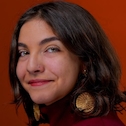Using trowels, brushes and small hand picks, Elaine Sullivan and her team of archeologists dug carefully into the tomb in Syria.
They also used hand sieves, pressing larger pieces of dirt onto them to catch small artifacts they could miss.
Only two people could fit inside the confined space at the same time.
Sullivan remembers the moment they found a finger-length clay cylinder the same color as the dirt. It initially seemed unremarkable. Then she took a closer look.
The clay cylinder they unearthed had scripts on them.
“This is something strange,” Sullivan recalls saying at the time.
She immediately called over her supervisor, Glenn Schwartz, who hesitated to make assumptions as the study of early alphabets — known as philology— is not his area of expertise.

As an archeologist at Johns Hopkins University, where he has researched since 1986, Schwartz was supposed to draw conclusions from early societies based on what he uncovers from tombs and excavations in Syria.
For years, Schwartz attempted to draw some measured attention to the team’s 2004 findings, hoping someone more qualified than he would become interested in the curious scripts. The current literature and understanding is that speakers of a Semitic language in Egypt developed alphabetic writing sometime in the Bronze age, drawing inspiration from the Egyptian system. Alphabets made writing accessible to people beyond royalty, changing how people lived, thought and communicated, Schwartz said.
But these cylinders his team found may have changed everything.
The cylinders precede other scripts by 500 years, challenging what archaeologists previously thought about the origin of alphabets. Schwartz presented his findings at an international conference with more than 1,000 experts from around the world late November. The annual meeting at American Society of Overseas Researchers, its executive director Andrew Vaughn said in a statement, is the venue for “important scientific announcements.”
“None are more important than this presentation of humanity’s earliest-known alphabetic writing,” Vaughn said. “ASOR is proud and pleased to be the place not only of the announcement, but just as importantly, where scholars from around the world can discuss its significance and how this discovery helps us understand the history of human civilizations.”
The organization honored Schwartz with the G. Ernest Wright Award for his book, where he writes about his findings and the excavation reports.
At the time, Sullivan was disappointed the scripts were not written using ancient Egyptian writing, or hieroglyphs, as she first thought.
“But now I see, 20 years later, how much more exciting it is that these symbols instead seem to be evidence for alphabetical writing at this very unexpected time and place in Syria,” said Sullivan, who is now a professor at University of California in Santa Cruz.
‘Never seen anything like this before’
Schwartz began the project in 1994, traveling to Syria in the late spring and early summer months every other year or so. He recruited graduate students and archeological specialists to go with him, and usually hired up to 30 people from a small town near the site to help with the digging.
The researchers started digging at dawn, when the temperature was still bearable, and worked until 9 a.m., Schwartz said. They slowly got used to the heat as the sun rose.
Then they would eat breakfast and head back to the site, where they took notes on what they excavated. Sometimes, if it was too hot, they had a little nap before working later in the afternoon.
At night, they slept on the flat roof of a house.
“We’d sleep under the stars,” he said. “It was very beautiful.”
When Schwartz and his team unearthed the cylinders in 2004, he remembers thinking, “What in the world is this? I’ve never seen anything like this before.”
But the researchers were too busy documenting all the objects to think further. It wasn’t until Schwartz traveled back to Baltimore and started going over his notes and photographs that he wondered if the script could be writing.
He decided to share his findings, hoping that philologists would study them and give their opinion. He published a report of his excavations in 2006, but the cylinders went largely unnoticed until earlier this year, when an expert in early alphabetic writing said in a scholarly article they agreed with Schwartz’s findings.
Schwartz had expected more skepticism from the American Society of Overseas Researchers, the main scholarly organization for the study of the ancient near east in the country.
“It’s quite a shock both chronologically and geographically,” he said. “If it really is alphabetic writing, then we have to rethink our understanding of how the alphabet was invented.”




Comments
Welcome to The Banner's subscriber-only commenting community. Please review our community guidelines.